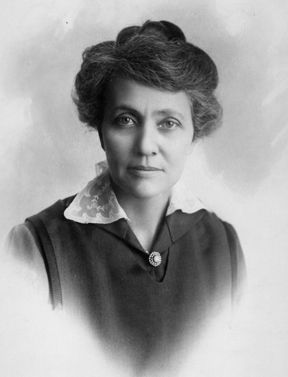Early Settlement of Meade County
By Carrie Schmoker Anshutz
(Written in 1935)
Meade has reached the half century mark. As one early settlers of Meade County, I have been asked to write a sketch of those early years when the first homes were being established; something of the problems that those early pioneers had to meet and overcome, and of the conditions that existed at the time compared with the present.
Bands of antelope roamed over the high flats and deer could be found in the rough country. In 1876 a few homesteaders came to the upper Crooked Creek Valley. Also, I believe the first cattle ranching began that year. In 1879, a number of homesteaders appeared and all settled along Crooked Creek Valley.
My father, Chris Schmoker and his brother John Schmoker, with their families, were among the first who came in April 1879. Meade County's population got quite a boost when the Schmoker families arrived for in my uncle's family there were nine children and in ours six. I was past a little past 10 then so my memories of those early years must of necessity be childish ones but they are quite vivid ones nevertheless.
Coming from a home in eastern Iowa to Dodge City in 1879 was almost like entering a new world. Dodge City at that Time was known as the "Cowboy Capital of the Southwest."
While our freight car was being unloaded on a siding, a group of people who called themselves "The Ohio Colony" arrived and set up tents nearby. On making the acquaintance of these people it developed that they too, were bound for homesteads in Meade County, and would be located about six miles from our homesteads. Our mothers and we children walked down there and visited with those people who were to be our neighbors.
When our car was unloaded a couple of freighters were hired, and their wagons and our own were piled high with "goods and chattels." The whole was topped by a not inconsiderable weight of human freight. We left Dodge City and crossed the Arkansas River over the old wooden toll bridge and traveled south and west over the Plummer Trail. In all that distance from Dodge to about three miles from the present site of Meade we saw not a single home, fence, field, or tree, nothing but the brown trail and on every side as far as the eye could reach just grassy prairie land that was not green for there had been no rain for many months. On the high flats we saw a few prairie dog towns and we met a few freight outfits going into town.
We camped that night and had our first experience of sleeping on the ground and eating food cooked over a camp fire. Next morning we resumed our slow journey and some time that day we reached our homesteads where the wagons were unloaded and tents set up for our new homes.
After some searching the Lockhart spring was found which was to furnish our water supply.
The Lockhart family had not yet arrived, although filing had been made on the claims. In a short time they came and were among the ones who remained permanently in the county. To us, all that dry hot summer this Lockhart spring was an oasis in the desert for around it was the only green spot anywhere in sight. Brilliant flowers grew here in abundance and because of their deep wine color, we named them "Wine Cups."
No rain fell that summer, just a few sprinkles. We planted a small garden but not one seed sprouted. The following winter was mild and dry. In March there was quite a snow and it was cold for a few days.
In the meantime we had made the acquaintance of our neighbors. The Eliason family was one of them who had come earlier than us. There was also a Captain French and others. Far up the creek were the Conrad and McCauley families who were among the first settlers.
A beautiful grove of natural timber, the only one in Meade County grew along this part of the creek. It was then known as the "Emerson Grove." It was known as that because George Emerson, the first Meade County cattle man, had his headquarters ranch there. He had a large sod house and corrals made of poles cut from the grove. When we came to the county his cowboys were "line herding" a bunch of his cows on the wide meadows that are now included in the Crooked L Ranch. His cowboys were the first whose acquaintance we made. George DeCow, young, daring, a reckless rider, Billy DeFreese, genial and fun loving, "Spike" Rexford and others whose names I have forgotten, a lively bunch always playing pranks on one another. At the "Big Springs" ranch lived Mr. Ed Blosom with his wife and stepson. They kept a flock of sheep. Their house on the hillside was part dugout and built up of sod, three rooms downstairs and two upstairs. Mrs. Blosom was lonely with the men gone all day herding sheep so she persuaded me to stay with her for company for some time. Once every two weeks we drove down to the settlement for the mail and those were red letter days for me. There were no roads.
We drove across the valley to the Jones and Plummer Trial to the "Hoo Doo" Brown Road Ranch then just built, two low sod buildings, one for a dwelling and the other for a store in which groceries, whiskey and tobacco were kept. From "Hoo Doo" we went north to our place and on to the Post Office in Meade County established by the Ohio Colony. For a number of years this Post Office Pearlette, the first post office and a store were kept by William Jobling's parents. Later Belle Meade Post Office was established several miles nearer to us and we got our mail there. It was first kept by a family named Milligan.
It was on one of our trips to the post office that we heard a baby boy had been born to the Eliason family. He was the first white child born in Meade County.
Near Belle Meade Post Office was a cluster of homesteaders__John Worthis, Franklin Sourbiers, Oliver Normans, Petersons and several others. At the Sourbier farm home was organized our first Sunday school and here all who were inclined met every Sunday afternoon for an entire summer. For seats, boards were laid across chairs, wagon seats were brought in and so we managed. Attendance was good for all were drawn together by the common purpose of building homes.
None could make a living farming so some of the men turned to freighting, some to bone picking and others to stock raising. A ton of buffalo bones brought from eight to 10 dollars in Dodge City. Some of the homesteaders were forced to leave after a year or two, but more kept coming in. Each July 4th, a celebration and picnic was held at the Emerson Grove and all met there for a sociable good time.
I think it was July 4, 1884 that we had our first real good rainfall. About 4 o'clock a dense black cloud appeared and everyone started home. A steady downpour lasted hour after hour all night. Flood followed leaving a chain of shallow lakes that remained for several years. Thousands of snipe, curlew, ducks, geese and cranes came that autumn. It was a hunters' paradise. During those first years it was our mothers who saw the most hardships. They were very lonely for often the husband and father was away for days, even weeks at a time, leaving mother and children alone with no near neighbors. Water was hauled in barrels, never really enough water for washing. The stoves were small and for fuel buffalo or cow "chips" were used which kept one member of the family busy stuffing the stove.
Food was scarce, there was no variety and most of the settlers had no milk. In case of sickness the nearest doctor was in Dodge City.
One of the problems was schooling for their children. The first year we were required to have lessons at home, but the following autumn a small frame building was erected near the Peter Blair home and three months of school was held there. The school was built and maintained by subscription, and when the county was organized it became District No. 1. Our teacher was Miss Alice Waire of what would now be termed Fowler community. Her pay was $15 a month and board. The Schmoker, Blair and Eliason children attended this first school.
I was a pupil in the first school held in Meade. The Christian Church was used that year for school purposes. Two other pupils I can remember were Richard Boyer and Brother Buis. Our school year was all work and no play. Three teachers were employed. Mr. M.C. Huston was superintendent and the teacher of the higher grades, Miss Ruth Logsdon had the intermediate department and Miss Abbie Wightman, later Mrs. Abbie Bodle, was the young teacher for the primary department.
When the county was organized my father was a member of the board of county commissioners. It was during his term of office that bonds were voted for the Rock Island Railroad right-of-way through Meade.
The problems of today are somewhat different, but they will require the same qualities of endurance and courage in the face of disappointment, adaptability and high purpose that characterized the struggles of the old time pioneers. I feel sure future generations will not be found lacking.
__ Condensed for the Meade County History Book
From
Pioneer Stories of Meade County
Fourth Edition _ 1985 (Pages 132-134)
Republished with the permission and cooperation of The Meade County Historical Society

